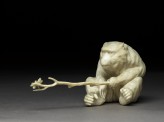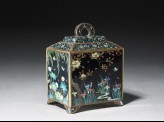The Ingrams in Japan
A story about Sir Herbert and Lady Ingram’s honeymoon in Japan, where they collected hundreds of objects now in the Ashmolean’s collection.

After sailing through the Inland Sea to Kobe, the Ingrams took a train to Kyoto where they stayed at the Miyako Hotel, which was very accustomed to foreign visitors and is still in existence today. A guide was hired for three months of their stay in Japan to escort the Ingrams to the various sights and shops. Mrs Ingram, who was not in good health, was unable to accompany her husband on a number of occasions, frequently remaining in the hotel. Thus Mr Ingram was obliged to set off without her, usually returning with various treasures to share with her.
Mr Ingram was a keen photographer and we are fortunate to have a few of his pictures, although some were destroyed before their return to England.
The guide arranged a programme which included visits to many of the famous sights, a tea ceremony, dance performances, a sumo wrestling match, and the ancient Aoi matsuri, a splendid and colourful annual festival in Kyoto. Mr Ingram even took a number of jujitsu lessons, but throughout their stay diary entries refer as much to the 'curio' hunting as to the sights.
Mr Ingram clearly enjoyed the whole process of hunting for and acquiring a new collection of Japanese artefacts. One day, after visiting various sights he concludes his diary entry with 'the usual business of curio shopping which I enjoyed as much as usual'.
Mr Ingram's taste appears to have been very eclectic. His purchases in Japan covered a wide range of objects, mostly small things such as netsuke, inrō, lacquer boxes, ceramics, and sword furniture. Although packing and shipping costs were high, by the time they left Kyoto on 14th April 1908, they had accumulated almost 400 objects which they sent home from Yokohama. The following items were among them:
 Okimono, or ornament, in the form of a monkey holding a branch (EA1956.3998)
Okimono, or ornament, in the form of a monkey holding a branch (EA1956.3998)
 Casket with flowers and butterflies (EA1956.4001)
Casket with flowers and butterflies (EA1956.4001)
 Blue Bizen ware figure of a phoenix (EA1956.1991)
Blue Bizen ware figure of a phoenix (EA1956.1991)
 Netsuke in the form of Kiyohime (EA1956.3263)
Netsuke in the form of Kiyohime (EA1956.3263)
 Satsuma kōgō, or incense box, with chrysanthemums (EA1956.665)
Satsuma kōgō, or incense box, with chrysanthemums (EA1956.665)
 Satsuma hot water pourer with pine, bamboo, and plum (EA1956.691)
Satsuma hot water pourer with pine, bamboo, and plum (EA1956.691)
The cloisonne casket [EA1956.4001] was bought in Kin’unken the shop attached to Inanba Nanaho's workshop, which continued in business until the late 1990s.
The Satsuma hot water pourer [EA1956.691], for which they paid the outrageous sum of 60 yen, is illustrated in Lady Ingram's article.
© 2013 University of Oxford - Ashmolean Museum

